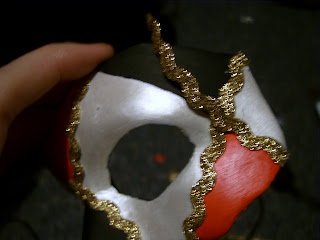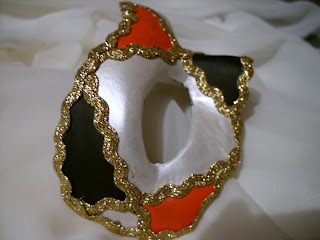A couple of weeks ago whilst exploring the internet I came across some images of venetian masks and I thought wouldn't it be fun to make one?! After a fair bit of research I'd found that there are several ways of going about this, the traditional way being paper mache, but I'm going with a plaster of paris base.
The finished mask.
First you need to design your mask or at least have some rough idea of what its going to look like. The major decision is symmetrical or asymmetrical. The problem with symmetry is that it's quite a lot of hard work to get it looking perfect however I have a couple of tricks for helping with this.
The materials you will need are:
- Plaster of paris bandage or "Modroc" as it's sometimes called.

- Polyfilla or any type of acrylic repair putty.

- Sandpaper (course and fine)
- Sponge applicator, I chose to use an artists sponge brush but you could use any sort of sponge.

- Vaseline
- Acrylic paint - white plus whatever colours take your fancy
- Plaster/putty knife

The first thing you need to do is a bit of prep. Being that I chose to make my mask symmetrical I cut out some cardboard shapes to act as a pattern. The simplest way to do this is to cut out the complete shape of the mask and chop it in to the bits you need. I ended up with one piece as a guide for the top, one for the side, one for the bottom, and two bits to guide eye hole shape. If you are going with an asymmetrical shaped mask you can get away without this step except perhaps the eye hole guides which will help with eye shape in any case.

Step 1. Cut out pieces of modroc/bandage. Cut around your little pattern pieces on the bandage, you need enough for three layers on each side of the face. Also chop up some strips and squares of various sizes.
Step 2. Apply vaseline generously to you or your 'victims' face. This is really important, especially over the eyebrows You must apply a layer to protect your skin or the plaster of paris will happily stick to it. Follow any other instructions on the packet of plaster bandage carefully. Lay down some newspaper and wear old clothes.
Step 3. Dip a piece of plaster bandage into a bowl of warm water to activate it and apply to the face. I started at the top - across the forehead and worked down. As you work think about how you are placing the strips, make sure they overlap and that everything is fusing together well. You need about 3 layers for a sturdy mask.
Step 4. Sit back and wait for the mask to dry. This doesn't take very long, about 30 mins. The mask tends to feel quite cold against the skin and you can gently wriggle your facial muscles to start loosening it from your face.
Step 5. Remove the mask from your face, again, let your facial muscles do the work, pull lots of faces and it should come away. I would advise leaving the mask overnight to ensure it can harden properly.
Pictures of the finished plaster of paris mask. After you have allowed it to dry overnight you can gently inspect it for any faults or crumbly bits. Any parts that are in danger of falling off can be reinforced with more plaster of paris bandage. Carefully wet the area of the mask that needs repair and apply bandage.
Part 2 coming soon!












































